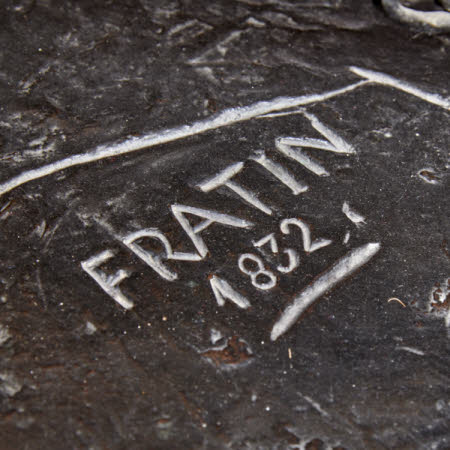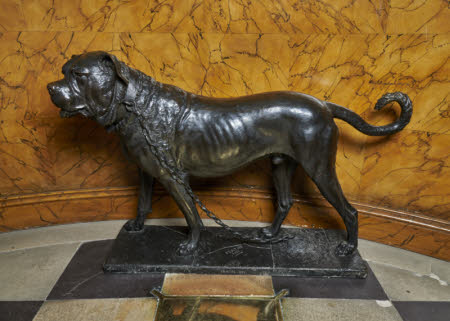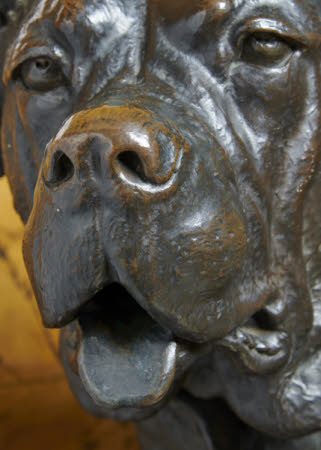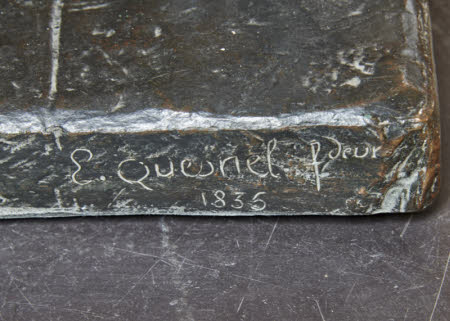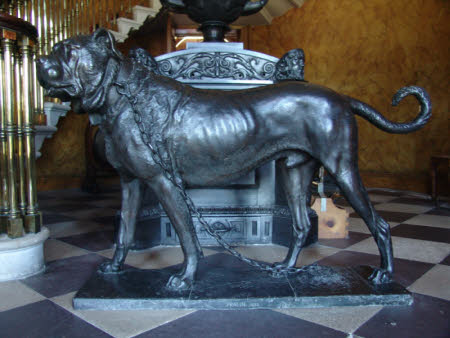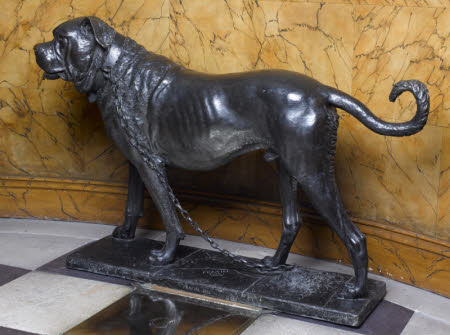A mastiff
Christophe Fratin (Metz 1800 - Le Raincy 1864)
Category
Art / Sculpture
Date
1832 - 1835
Materials
Bronze
Measurements
914 x 381 mm; 1377 mm (L)
Place of origin
Paris
Order this imageCollection
The Argory, County Armagh
NT 565214
Summary
Sculpture, bronze; A Mastiff; Christophe Fratin (1800-1864); 1835. A life-size bronze figure of a mastiff, by the ‘animalier’ sculptor Christophe Fratin. Cast by the bronze founder Édouard Quesnel (c.1792 – before 1858), it is one of two impressive bronze figures of dogs by Fratin at the Argory.
Full description
A life-size figure of a mastiff, standing with an alert expression, wearing a collar, to which is attached a chain, fixed to a ring in the ground just behind the animal’s back right paw. The chain is partly cast with the dog and partly formed of separately cast and free-moving links. On an integral base with a textured surface. The base is signed an dated both by the sculptor, Christophe Fratin (1800-1864), who created the model in 1832, and by the founder who cast the bronze in 1835, Édouard Quesnel (c.1792 – before 1858). A pair to a bronze sculpture of a greyhound with a hare (NT 565213). Christophe Fratin was a member of a school of French nineteenth-century sculptors which, long after their deaths, collectively came to be known as the ‘Animaliers’, because much of these artists’ work consisted of animal subjects, depictions of wild and domestic animals. Other leading members of the movement include Antoine-Louis Barye (1796-1875), Emmanuel Frémiet (1824-1910) and Pierre Jules Mène (1810-1879). The success of the Animaliers lay in part in these sculptors’ use of new technologies, allowing casts of sculptures to be made more cheaply and efficiently, but was also partly due to the emergence of a broader market, as the middle classes in nineteenth-century Europe became wealthier and more powerful participants in the art market. Fratin was born in Metz in Eastern France, the son of a taxidermist, moving to Paris as a young man. He began as a pupil of the painter Théodore Géricault (1791-1824), but went on to practise as a sculptor, exhibiting at the Salon throughout his life. He first exhibited at the Salon in 1831, showing a sculpture entitled ‘Fermer, an English Thoroughbred. He was highly successful as a sculptor in Britain as well as in his native France. His reputation really took off with the Salon in 1839, at which he showed his famous bronze group of 'An Eagle and Vulture Disputing their Prey.' This was the work that he showed, among others, at the Great Exhibition in London in 1851, and for which he was awarded a medal, the citation describing Fratin as "the most celebrated sculptor of animals in France at the present day." Fratin was highly regarded for the individualistic and painterly style of his modelling. Unlike other animalier sculptors such as Barye, he had no foundry of his own, so did not make his own bronze sculptures, but had to subcontract this work to foundries. In fact, a large proportion of the works he exhibited were not in bronze, but in the less durable materials of plaster or terracotta. Despite his popularity, works by Christophe Fratin are rare in public collections in Britain and Ireland. The two remarkable life-size sculptures of dogs at the Argory are probably the most important sculptures by him in a public collection in these islands. Much larger than the great majority of Fratin’s animal sculptures, they date from early in his career, the model of the mastiff being dated very early, 1832. Both sculptures were cast for Fratin in 1835 by Édouard Quesnel, one of the great pioneers of the sand-casting technique for bronze casting. Quesnel’s business partnership with Louis Richard, another sand-casting specialist, had been established in 1821 and came to an end in 1834. In the following year, 1835, Quesnel entered into a new commercial arrangement with Christophe Fratin, which envisaged the creation of an expanded market for the sculptor’s work, through the large-scale production of bronze casts of his models. The venture however quickly failed, since the two men had overestimated the market. In 1839 Quesnel went bankrupt and turned against Fratin, bringing the sculptor down with him. In 1835 on the other hand, when the two dogs at the Argory were both cast, the partnership was young and full of optimism. The impressive sculptures are therefore among the first fruits of the new partnership, the prominent signatures of both sculptor and founder suggesting the two men’s pride in their new venture. Fratin also entered, at quite an early date, into partnership with the Coalbrookdale Company which marketed casts in both bronze and iron of works by living sculptors, for example John Bell. There are at the Coalbrookdale Museum of Iron in Telford bronze casts of a pointer and a greyhound with a hare at its feet by Fratin, the same sort of size as the Argory models, but dating from considerably later. Fratin’s greyhound, a variant of the Argory model, and his pointer appear in Coalbrookdale Company catalogues for 1875 and 1877, and there are examples of both these models in iron at Belton House (NT 436806). The bronzes at the Argory were bought for the house in 1902 by Captain Ralph Shelton from the sale of the contents of his friend Harry Verner’s home, Churchill House, Verner’s Bridge, Co. Armagh. Jeremy Warren July 2022
Provenance
Verner collection, Churchill House, Verner’s Bridge, Co. Armagh; bought by Captain Ralph Shelton at the sale of the contents of Churchill House, 1902; by descent to Walter MacGeough Bond (1980-1986), by whom given to the National Trust in 1979.
Marks and inscriptions
On side of base, at front:: FRATIN. 1832 On surface of base, below mastiff’s belly:: FRATIN 1832 On side of base at right, behind mastiff’s left hind leg:: E. Quesnel fdeur 1835 On surface of base, towards back:: [….] fondeur 1835
Makers and roles
Christophe Fratin (Metz 1800 - Le Raincy 1864), sculptor Édouard Quesnel , founder
References
Purdue 2005: Olwen Purdue, The MacGeough Bonds of The Argory. An Ulster Gentry Family, 1880-1950, Dublin 2005, p. 41.

